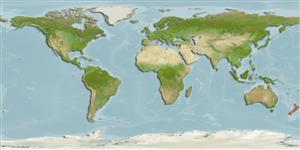Environment: milieu / climate zone / rango de profundidad / distribution range
Ecología
marino pelagic-neritic; rango de profundidad 0 - ? m. Temperate
Southwest Pacific: restricted to New Zealand, including the Chatham Islands.
Tamaño / Peso / Age
Madurez: Lm ? range ? - ? cm
Max length : 26.0 cm SL macho / no sexado; (Ref. 10988); common length : 22.0 cm TL macho / no sexado; (Ref. 9258)
Short description
Claves de identificación | Morfología | Morfometría
Espinas dorsales (total) : 0; Radios blandos dorsales (total) : 15 - 18; Espinas anales: 0; Radios blandos anales: 17 - 20; Vértebra: 55 - 58. Gill rakers usually 32 or less on the first arch and 25 or less on the second arch. Relatively longer upper jaw (usually longer than wide) and lower jaw (usually longer than head length), especially at larger sizes.
Body shape (shape guide): eel-like.
Occurs in inshore waters. Forms schools for spawning during mid summer (Ref. 9258). Feeds mainly on larger zooplankton like mysids, crab larvae and polychaete larvae (Ref. 26966).
Life cycle and mating behavior
Madurez | Reproducción | Puesta | Huevos | Fecundidad | Larva
Collette, B.B., 1974. The garfishes (Hemiramphidae) of Australia and New Zealand. Records of the Australian Museum 29(2):11-105. (Ref. 10988)
IUCN Red List Status (Ref. 130435: Version 2025-1)
Threat to humans
Harmless
Human uses
Pesquerías: escaso valor comercial
Herramientas
Special reports
Download XML
Fuentes de Internet
Estimates based on models
Phylogenetic diversity index (Referencia
82804): PD
50 = 0.5000 [Uniqueness, from 0.5 = low to 2.0 = high].
Bayesian length-weight: a=0.00102 (0.00046 - 0.00225), b=3.06 (2.88 - 3.24), in cm total length, based on all LWR estimates for this body shape (Ref.
93245).
Nivel trófico (Referencia
69278): 3.2 ±0.3 se; based on diet studies.
Resiliencia (Referencia
120179): Alto, población duplicada en un tiempo mínimo inferior a 15 meses (Preliminary K or Fecundity.).
Fishing Vulnerability (Ref.
59153): Low vulnerability (22 of 100).
🛈
Climate Vulnerability (Ref.
125649): High to very high vulnerability (73 of 100).
🛈
Nutrients (Ref.
124155): Calcium = 240 [58, 580] mg/100g; Iron = 0.655 [0.226, 1.848] mg/100g; Protein = 17.8 [15.0, 20.0] %; Omega3 = 0.518 [0.215, 1.478] g/100g; Selenium = 6.33 [2.15, 16.41] μg/100g; VitaminA = 59.3 [11.7, 294.2] μg/100g; Zinc = 0.776 [0.306, 2.099] mg/100g (wet weight); based on
nutrient studies.
